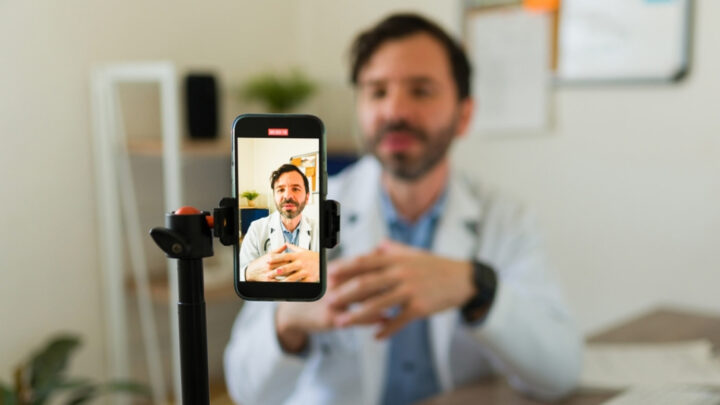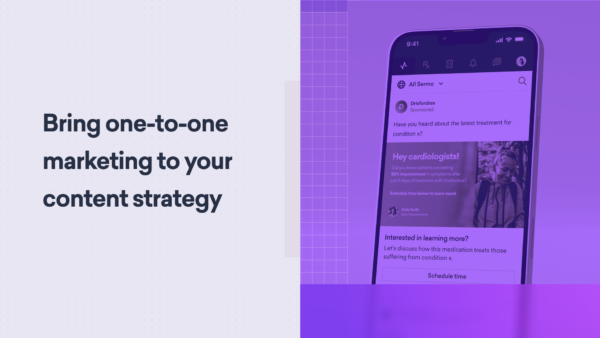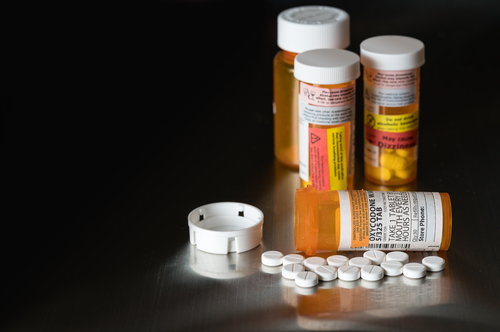
Every business needs a dedicated marketing plan, and pharmaceutical companies are no exception. Documenting your marketing goals and strategies helps everyone on your team stay on track and work cohesively.
A pharmaceutical marketing plan should be a living document that develops as your business grows. It should be flexible to suit market conditions and disruptions, so whatever happens, you can always position your company effectively.
Not sure how to write a pharmaceuticals marketing plan or which pharmaceutical marketing strategies to use? You’ll find all the information you need in this guide, including step-by-step instructions on compiling your marketing plan and a list of 14 successful pharma marketing ideas and strategies.
What Does Pharmaceutical Marketing Entail?
Marketing strategies for pharma companies have two primary audiences: patients and healthcare professionals (HCPs). To be successful, the tactics you use must engage with both audiences to:
- Build brand awareness
- Establish a reputation of trust and reliability
- Provide information about diseases, symptoms, and available treatments
- Communicate details of new drug launches and treatments
In earlier years of pharmaceutical sales, strategies went little further than employing enough sales reps to make regular HCP visits to promote products and services. However, the market has changed.
In today’s digital age, fewer and fewer HCPs are rep-accessible, and it’s estimated that the pharma industry spends over a billion dollars each year on unsuccessful attempts to see physicians. Plus, patients and their caregivers are not as reliant on HCPs for medical information as before. The internet has become a wealth of knowledge and a place where people can connect with other members of the disease community independently of their healthcare providers. This trend is likely to continue with 82% of pharma execs agreeing that digitalization will likely continue post-covid.1
In light of this, an omnichannel approach is required to connect with your audiences where they are most active. Your campaigns must be mobile-first because there are over 300 million smartphone users in America alone, all spending an average of 38 hours a week attached to their devices. Additionally, healthcare professionals are using social media more than ever to easily find information. On average, HCPs check social platforms at least three times a day, spending up to 2 hours throughout the day.
Effective pharma marketing strategies use a variety of digital channels to provide consistent messaging that reaches HCPs through the most relevant platforms and connects with patients to educate and inform them. When done well, the right pharmaceutical marketing strategies carry both HCP and patient target audiences through your sales and marketing funnel while also providing reps with the support they need to drive sales.
Building a Pharmaceuticals Marketing Plan
The ultimate goals of a solid pharma marketing strategy is to increase:
- Visibility
- Sales
- Revenue
- Return on marketing and advertising investment
However, knowing what you want to achieve doesn’t necessarily mean you know how to get there. If you’re going to spend time, money, and resources developing a pharmaceutical marketing plan, you want to know that your efforts will pay off. Here are the steps to follow.
1. Define Your Audience
The first priority is establishing your market so you can select the correct communication channels to reach your audience. That means nailing down the specific groups of HCPs and patients you want to reach rather than casting your net as wide as possible and hoping for the best. Knowing which market segments fit your propositions helps you target them more effectively.
2. Set Your Goals
What market position are you trying to achieve? The answer will play a significant role in dictating which marketing strategies you use. The four most common goals are:
- Market Penetration – Increasing sales of existing drugs and treatments in existing markets.
- Market Development – Promoting existing drugs and treatments to a new market.
- Product Development – Introducing new drugs and treatments to existing markets.
- Diversification – Selling new drugs and treatments to a new market.
3. Define Your Unique Selling Propositions (USPs)
Defining your USPs will help you create the right content that sends the right message to the right people. To gain a competitive advantage, you’ll need to thoroughly review your USPs versus your competitors to ensure your product offering is truly above and beyond. Examples of pharmaceutical USPs include:
- Drug efficacy
- Service quality
- Experience and expertise
- Track record
- Price
- Fulfillment time
4. Ask the Right Questions
Hindsight might be 20/20, but why not use a crystal ball instead to inform your marketing strategy? Market research is your opportunity to ask your target audience about their specific needs.
But, before you decide on specific marketing tactics, it helps to ask yourself a few questions to ensure your marketing efforts will equate to increased sales.
- What emerging market trends do you need to account for?
- What communication channels best suit your audience?
- What kind of experience are you trying to create for your audience?
- How can you differentiate your drugs and treatments from those of your competitors?
5. Set Some Key Performance Indicators (KPIs)
What’s the point in developing a pharmaceuticals marketing strategy if you have no way of assessing how effective it is? The specific metrics you measure will depend on your goals, but some common examples include:
- Average revenue per HCP
- Inventory turnover
- Non-prescription sales as a percentage of total sales
- Overall sales, revenue, and profit
If you are including targeted pharma marketing strategies in your overall marketing plan, you may also wish to include metrics that tout the efficacy of a drug or the reputation of your brand.
With these steps followed, you can start to focus on more specific pharmaceutical marketing strategies and drive your campaign forward.
14 Pharmaceutical Marketing Strategies
Let’s take a more in-depth look at some of the different tactics you can use to optimize your pharmaceuticals marketing strategy.
1. Update Your Website
Your website is a virtual representation of your company resume. As a result, revamping it every now and then so it retains a modern and attractive look, contains the most up-to-date information, and is straightforward to navigate is vital. Information should be easy to find, and you should work with your developer to ensure your site:
- Is mobile-friendly – Research shows that 92% of the top pharmaceutical manufacturer’s websites pass Google’s mobile-friendly test. Yet, none of the top 25 meet Google’s Core Web Vitals standards, and 92% fail Google’s mobile speed test.
- Adopts accessibility best practices – According to the CDC, 1 in 4 Americans has a disability that can make accessing information online difficult. This includes hidden disabilities like vision problems, neurological differences, cognitive impairments, language issues, and learning difficulties, in addition to physical disabilities and mobility issues.
2. Invest in Pharma SEO
Did you know that Google receives over 1 billion health questions every day? Updating your web copy to include more keywords and improve metadata and alt tags will improve your Google ranking. Adding additional pages allows you to incorporate more internal and external links and include local SEO and long-tail keywords that will help you to gain domain authority. Publishing a regular blog is a great way to increase your website size and add all-important SEO data to please the Google machine, while also showcasing your product range, experience, and expertise to raise HCP and patient awareness of your brand.
3. Use Online Communities to Connect with Physicians
LinkedIn is the internet’s largest professional network. However, you should also join HCP-specific channels like Sermo to ensure you are reaching a verified, targeted audience. When you work with Sermo, you gain access to more than 1.3 million healthcare professionals across 150 countries, allowing you to network more effectively with your HCP audience.
4. Establish a Social Media Presence
Americans spend an average of 2 hours and 27 minutes on social media every day, so being active on the same platforms as your target audience is essential. HCPs are more active on social media than ever before, and social engagement is taking off. For example, we’ve witnessed an increase in 70% of physicians sharing their drug knowledge through Sermo’s Drug Rating platform, and participation in polls has skyrocketed by almost 300%.
5. Use Customer Relationship Management (CRM) Technology
CRM technology is a must for your pharma marketing strategy to succeed. It helps you gather and action information about your leads so you can build trusted and long-lasting relationships. CRM tools capture and centralize data concerning communication preferences, relationship history, and online behaviors, etc. Examples of how you can use this data include:
- Sending customized email campaigns based on clicks on your website
- Cross-selling new drugs and therapies based on previous uptake
- Sending personalized messages for birthdays and other key milestones to personalize each recipient’s journey with you
- Providing after-sales support
- Sending free sample offers
6. Provide Free Samples
On the topic of free samples, this is one of the most traditional marketing strategies for pharma and is a good idea if your HCP networks allow it. After all, physicians will be more likely to prescribe a drug if they have received a free sample. However, you should exercise caution and ensure samples are distributed responsibly.
7. Create Visual Aids
Educational posters provide additional value in your product offering to physicians while simultaneously boosting your brand’s visibility. When placed in their clinics and offices, more potential customers will see them, which increases the chance of conversions.
8. Maximize Networking Opportunities
What better way to fine-tune your pharmaceutical sales strategies than by speaking to members of your target audience at professional networking events to gather their comments and feedback? Attending conferences and events is one of the best ways to network with HCPs. In a recent Sermo poll, 94% plan to attend an in-person event this year (the remaining 6% will attend a virtual event).2
9. Use Different Approaches for Each Audience
The tactics you use to convert HCPs are unlikely to have the same effect on patients and vice versa. Neither market uses the same platforms or research techniques, and the USPs they are interested in will vary significantly. The tone of your communications will also need to change. For example, patients are usually more receptive to an emotional or empathetic approach, whereas HCPs typically appreciate more analytical, data-driven communications.
10. Be Patient-Centric
Because patients can research and cross-reference information given to them by their HCPs using the internet, it’s more important than ever to build trust and keep patient needs as the focal point of your pharma marketing strategies. By identifying where patients look for information about symptoms, drugs, and therapies, and finding forums where they share their experiences online, you can use the same channels and design marketing campaigns to reach them more easily.
11. Navigate the Cost of Treatment
It’s estimated that the mean cost of developing a new drug ranges between $314 million to $2.8 billion, yet only around 12% are ever approved by the FDA. To ensure the best chance of return on investment (ROI), your marketing plan should emphasize payer marketing, including strategies that target insurance providers and educate patients about financial aid opportunities.
12. Pay for Leads
If your budget allows it, paying for advertising and leads can make a big difference. Healthcare and insurance have among the highest cost per lead, so outsourcing some of the effort may save you valuable time and resources in the long run. Finding customers through paid means typically takes one of two forms:
Google ADS – Some careful research is required to capitalize on the right keywords to get the best quality score. Still, websites that pay for ads usually appear at the top of page 1 search results, increasing your visibility and making conversions more likely.
Paid Leads – Outsourcing to a reputable lead generator produces a higher volume of better-quality leads, ultimately increasing your conversion rate and sales revenue. Professional lead generation services automate data collection and ensure only the prospects who are most likely to buy are included in each campaign.
13. Consider The Regulations
Whatever pharma marketing ideas you have, you must ensure your communications do not fall foul of HIPAA regulations or FDA laws, meaning your marketing messages must be truthful regarding drug efficacy and consistent with FDA-approved prescribing information. You must also ensure your pharmaceutical marketing strategies align with privacy legislation like the General Data Protection Regulation (GDPR).
14. Measure and Adjust
It’s impossible to know if your strategies are working or allocate future marketing budgets without analyzing data. You’ll need to go back to the list of KPIs in your marketing plan and monitor them consistently. Only then will you be able to develop a formula for long-term success. Assess each KPI against your marketing objectives. Depending on which strategies you implement, you may have many variables to measure. As your marketing efforts progress, you may wish to refine your measurements into various categories to assess ROI more thoroughly.
- Sales KPIs – Number of new HCP contracts, dollar value of new contracts, number of engaged qualified leads, net sales, etc.
- Financial KPIs – Revenue growth, net/gross profit margin, operational cash flow, etc.
- Customer KPIs – Number of HCPs retained, market share percentage, Net Promoter Score (NPS), etc.
- Operational KPIs – Sales by region, order fulfillment time, time to market, etc.
- Marketing KPIs – Website traffic, SEO results, email bounce/conversion rates, social media engagement, etc.
1 Accenture New Rules of Engagement Survey, 2021 | Deloitte Biopharma Digital Innovation Survey, 2021
2 Sermo Omnichannel RealTime Survey
Power up Your Pharma Marketing Strategies with Sermo
We turn physician experience, expertise, and observations into actionable insights for the global healthcare community. Engaging with more than 1 million HCPs across 150 countries, we provide physicians with a social platform that fosters impactful peer-to-peer collaboration and discussions about issues that are important to them and their patients. Sermo offers on demand access to physicians via a suite of proprietary technology to provide business intelligence that benefits pharmaceutical, healthcare partners and the medical community at large.
Interested in learning more? Check back any time and follow us on Facebook, Twitter and LinkedIn for the latest and greatest in healthcare insights.
To explore our exclusive business solutions, please visit us at sermo.com/business or email us business@sermo.com.














